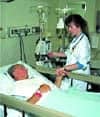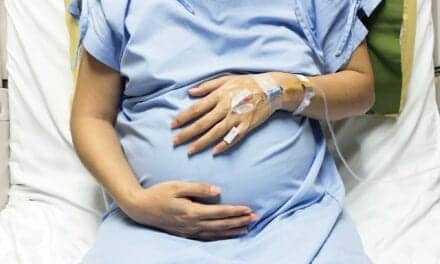Computed tomography scans can offer physicians detailed information on ARDS patients such as morphological descriptions, recognizing specific lesions, quantitative analysis of lung tissue, and the evolution of the disease

In most ICUs, obtaining a chest radiograph each day is the current practice. The chest radiograph remains the most commonly used diagnostic tool for following the evolution of lung disease in the ICU.4,5 The efficiency and effectiveness of routine daily chest films are, however, still under debate.6,7 The changes seen in the chest radiograph in ARDS are characteristic, but nonspecific, and therapeutic interventions may alter the radiographic findings. Unfortunately, the accuracy of the routine radiograph in distinguishing hydrostatic from increased-permeability edema is not high; at best, this test is unlikely to yield more than a 60% to 80% accuracy of diagnosis when applied in vacuo.8 Several studies consider CT scanning to be part of the routine management of ARDS, and it has become a very popular tool.8-11 The detailed, accurate images provided by CT scanners have encouraged physicians to use CT more frequently, mainly to improve the description of the pathological process.
CT scans offers many advantages. They avoid superimposition of different structures and allow accurate measurement of the extent of abnormalities and the density of structures of interest (the superimposition of differing pathologies, such as pleural effusion, pneumothorax, and lung consolidation, can be undetectable on conventional chest films). CT scans do, however, carry some disadvantages They are costly, they expose patients to a higher amount of radiation than standard chest radiographs do, and they can increase morbidity related to transportation to the CT suite.10,11
CT scanning is an accurate method of measuring regional radiographic density12 (the property of substances that permits absorption of x-rays), and it is well correlated to physical density.11 Radiographic density is usually expressed in Hounsfield units (H). These are scaled from air (-1,000 H) to water (0 H) to bone, which usually has a density of more than +1,000 H. In ARDS patients, the radiographic density of dependent lung regions is around 200 H.11
Diagnosing ARDS
During early phases of disease, CT scanning reveals ground-glass opacities and heterogeneous consolidation distributed peripherally and mainly in the dependent portions of the lung, but it also can include patchy infiltrates with lung areas of normal appearance (preservation of normal lung regions in ARDS).13 When analyzing lung CT scans, Pelosi et al14 and Sottiaux15 assessed the relative regional proportion of tissue volume (lung tissue, extravascular water, blood, and fibrin) and gas volume in normal subjects and patients with ARDS who were supine. The authors showed a high rate of decrease in the gas-to-tissue ratio from ventral to dorsal lung levels in ARDS patients.
Normally, the gas fraction reaches approximately 62% to 65% of total lobe volume; in ARDS patients, the lower lobe’s gas fraction represents only 12% to 18% of the overall lobe volume. Volume of the lungs’ lower lobes is greatly reduced in ARDS patients secondary to a severe loss of gas, and nearly total alveolar collapse is observed, especially in the most dependent regions. The dependent distribution of apparent lung damage may, in fact, reflect gravity-provoked atelectasis rather than more severe disease.
Air bronchograms, bronchial dilatation, and pleural effusion are common findings in ARDS.16,17 CT scans can suggest the presence of lung abscesses and blebs, mainly in dependent portions of the lung.18 With this image study, the physician can detect unsuspected postoperative abdominal or mediastinal abscesses and early barotrauma (interstitial pulmonary emphysema, pneumothorax, pneumomediastinum, pneumopericardium, and subcutaneous emphysema) secondary to mechanical ventilation.19 A small pneumothorax can often be difficult to diagnose using chest radiographs alone, but CT scans can easily lead to its identification. Drainage of mild pneumothorax and pleural effusion can also be facilitated under CT scan guidance.11
CT scans have demonstrated that there is a reversal of lung opacification when patients with ARDS are in the prone position; densities move from dorsal to ventral positions, following the gravitational field.19
CT Scans and Mechanical Ventilation
Ventilatory strategies preventing alveolar overdistension and cyclic end-expiratory collapse in ARDS patients are now widely accepted.15 The main recruitment maneuvers include prone positioning, extrinsic positive end-expiratory pressure (PEEP), periodic deep breaths or sighs, sustained inflation, or continuous/bilevel positive airway pressure. Recruitment implies the use of relatively high levels of pressure. These maneuvers could be useful in improving oxygenation, decreasing shunt fraction, sustaining lung volume, and reducing the amount of atelectasis.15 CT scans are also a powerful tool for measuring lung recruitment. This can be quantified by measuring how much nonaerated tissue becomes aerated by the application of different levels of PEEP.20 Alternative approaches include computing changes in the weight of normally aerated tissue or computing the weight of consolidated tissue.11,20
The effects of PEEP in patients with ARDS have also been well demonstrated in CT scans.13 The application of PEEP is generally associated with the resolution of radiographic density and a decrease in the amount of consolidated tissue.21 Studies22 also show that, with this distribution of abnormalities, PEEP ventilation induces lung overdistension in the nondependent, normal lung, and that this portion of lung is susceptible to barotrauma.
There are studies23 evaluating tidal volume and recruitment by means of CT scans. These scans were taken at the end of inspiration and the end of expiration; they show that the amount of recruitment/derecruitment decreases with increasing PEEP at constant tidal volumes. Increasing PEEP also makes gas distribution more homogeneous.
Some investigators have used CT studies to interpret pressure-volume curves in patients with ARDS. Pressure-volume curves show respiratory performance and how mechanical ventilation and ventilator settings affect the respiratory system. In pressure-volume curves, the lower inflection point corresponds to the pressure at which recruitment takes place, while the upper inflection point is the pressure at which alveoli start to be overdistended.24 Investigators assessed the relationship between the shape of the pressure-volume curve and lung morphology using high-resolution spiral CT scans. These studies9 suggest that in patients without lower inflection points and with predominant consolidation of basal zones, there is a serious risk of overdistension at high PEEP levels. Patients who have lower inflection points and predominantly diffuse consolidation have considerable recruitment at high PEEP levels and little overdistension at the end of expiration.
Other issues
Two CT-scan abnormalities seen after weeks to months of follow-up care in survivors of ARDS are the presence of a reticular pattern and bronchial dilatation with distortion of lung architecture, predominantly distributed in areas that were nondependent.25
A study26 of abdominal CT scans in ARDS patients detected pathological findings in 75 (82%) of 92 patients. Hepatomegaly, found in 48 (52%), was the most common finding; free abdominal fluid was detected in 29 (31%); and splenomegaly in 25 (27%). The overall lethality in patients with pathological findings was about twice as high (23%) as in those without such findings (12%). The authors concluded that the prevalence of pathological findings in abdominal CT scans is a reliable indicator of unfavorable courses and outcomes in patients with ARDS. An increase in abdominal pressure can contribute to formation of atelectasis in the adjacent regions of the lower lobes, which CT scans can demonstrate.27
Conclusion
CT scans are being used with increasing frequency in ARDS patients. There are several clinical insights that CT scans can offer in ARDS patients, such as morphological description, recognition of specific lesions that were previously unrecognized, quantitative analysis of lung tissue, measurement of mechanical ventilation’s effects, and the evolution of the disease.
CT is also moving from being an investigational tool in this arena toward becoming part of the standard clinical management of ARDS patients. The main limitations of CT scans are the risks of transferring patients to the CT suite. In the near future, this risk could be reduced by the availability of bedside CT scanning. There are also unanswered questions remaining, and further investigation of this topic is required.
David Rubio Payán, MD, is a critical fellow; Department of Critical Care Medicine, Instituto Nacional de Ciencias Medicas y Nutrición, Salvador Zubirán, Mexico City. Jorge Pedroza-Granados, MD, is a staff physician in the department. Guillermo Domínguez-Cherit, MD, is head of the ICU at the institute.
References
1. Bernard GR, Artigas A, Brigham KL, et al. The American-European Consensus conference on ARDS: definitions, mechanisms, relevant outcomes, and clinical trial coordination. Am J Respir Crit Care Med. 1994;149:818-824.
2. Roberts PR, Balk RA. Respiratory failure/acute lung injury. In: Society of Critical Care Medicine 1998 Multidisciplinary Critical Care Board Review. Chicago: Society of Critical Care Medicine; 1998:595-611.
3. Hudson LD, Milberg JA. Clinical risks for development of the acute respiratory distress syndrome. Am J Respir Crit Care Med. 1995;151:293-301.
4. Pelosi P, Brazzi L, Gattinoni L. Diagnostic imaging in acute respiratory distress syndrome. Current Opinion in Critical Care. 1999;5:9-16.
5. Desai SR, Hansell DM. Lung imaging in the adult respiratory distress syndrome: current practice and new insight. Intensive Care Med. 1997;23:7-15.
6. Bekemeyer WB, Crapo RO, Calhoon S, Cannon CY, Clayton PD. Efficacy of chest radiography in a respiratory intensive care unit: a prospective study. Chest. 1985;
88:691-696.
7. Henschke CI, Pasternak GS, Schroeder S, Hart KK, Herman PG. Bedside chest radiography: diagnostic efficacy. Radiology. 1983;149:23-26.
8. Hall J, Schmidt G, Wood L. Acute Hypoxemic Respiratory Failure. Principles of Critical Care. 2nd ed. McGraw-Hill; 1998:537-564.
9. Vieira SR, Puybasset L, Lu Q. A scanographic assessment of pulmonary morphology in acute lung injury. Am J Respir Crit Care Med. 1999;159:1612-1623.
10. Tagliabue P, Gianatelli F, Vedovati S. Lung CT scan in ARDS: are three sections representative of the entire lung? Intensive Care Med. 1998;24:S93.
11. Pasenti A, Tagliabue P, Patroniti N, Fumagalli R. Computerized tomography scan imaging in acute respiratory distress syndrome. Intensive Care Med. 2001;
27:631-639.
12. Drummond GB. Computed tomog-
raphy and pulmonary measurements. Br J Anaesth. 1998;80:665-671.
13. Goodman P. Radiographic findings in patients with acute respiratory distress syndrome. Clin Chest Med. 2000;21:419-433.
14. Pelosi P, Andrea L, Vitale G, Pesenti A, Gattinoni L. Vertical gradient of regional lung inflation in acute respiratory distress syndrome. Am J Respir Crit Care Med. 1994;149:8-13.
15. Sottiaux T. Lung recruitment and stabilization in ARDS. Yearbook of Intensive Care and Emergency Medicine. 2001:418-434.
16. Goodman LR, Fumagalli R, Tagliabue P. Adult respiratory distress syndrome due to pulmonary and extrapulmonary causes: CT clinical and functional correlations. Radiology. 1999;213:545-552.
17. Howling SJ, Evans TW, Hansel DM. The significance of bronchial dilatation on CT in patients with adult respiratory distress syndrome. Clin Radiol. 1998;53:105-109.
18. Snow N, Bergin KT, Horrigan TP. Thoracic CT scanning in critically ill patients: information obtained frequently alters management. Chest. 1990;97:1467-1470.
19. Gattinoni L, Pelosi P, Vitale G, et al. Body position changes redistribute lung computed-tomographic density in patients with acute respiratory failure. Anesthesiology. 1991;74:15-23.
20. Puybasset L, Cluzel P, Chao N, et al. A computed tomography scan assessment of regional lung volume in acute lung injury. Am J Respir Crit Care Med. 1998;158:1644-1655.
21. Gattinoni L, Presenti A, Torresin A. Adult respiratory distress syndrome profiles by computed tomography. J Thorac Imaging. 1986;1:25.
22. Vieira SRR, Puybasset L, Richecoeur J. A lung computed tomographic assessment of positive end expiratory pressure-induced lung overdistention. Am J Respir Crit Care Med. 1998;158:1571.
23. Gattinoni L, Pelosi P, Crotti S, Valenza F. Effects of positive end-expiration pressure on regional distribution of tidal volume and recruitment in adult respiratory distress syndrome. Am J Respir Crit Care Med. 1995;151:1807-1814.
24. Mancebo J. Measurement and interpretation of lung mechanics in patients with acute respiratory failure. Yearbook of Intensive Care and Emergency Medicine. 2001:411-417.
25. Desai SR, Wells AU, Rubens MB, Evans TW, Hansell DM. Acute respiratory distress syndrome: CT abnormalities at long-term follow-up. Radiology. 1999;210:29-35.
26. Mauer M, Stunzer T, Schroder RJ, et al. Clinical significance of abdominal CT in patients with ARDS. Intensivmedizin und Notfallmedizin. 1999;36:709-713.
27. Malbouirson L. Role of the heart in the loss of aeration characterizing lower lobes in ARDS. Am J Respir Crit Care Med. 2000;161:2005-2011.








